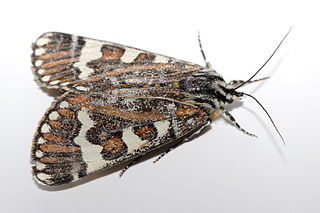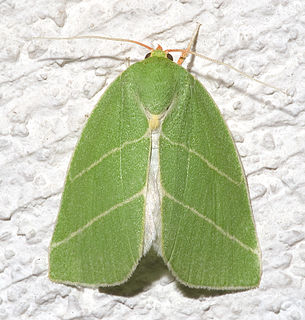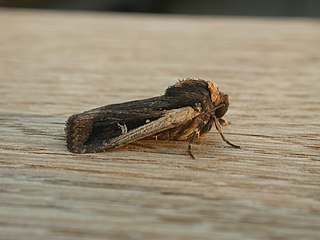
The Noctuidae, commonly known as owlet moths, cutworms or armyworms, are the most controversial family in the superfamily Noctuoidea because many of the clades are constantly changing, along with the other families of the Noctuoidea. It was considered the largest family in Lepidoptera for a long time, but after regrouping Lymantriinae, Catocalinae and Calpinae within the family Erebidae, the latter holds this title now. Currently, Noctuidae is the second largest family in Noctuoidea, with about 1,089 genera and 11,772 species. However, this classification is still contingent, as more changes continue to appear between Noctuidae and Erebidae.

The pasture day moth, Apina callisto, is a species in the moth family Noctuidae which is active during the day, as its common name implies, making it unlike most other noctuid species. It is found in most southern areas of Australia, ranging from lower Queensland to Tasmania. The species was first described by George French Angas in 1847. It is the only species in the monotypic genus Apina, erected by Francis Walker in 1855.

Cutworms are moth larvae that hide under litter or soil during the day, coming out in the dark to feed on plants. A larva typically attacks the first part of the plant it encounters, namely the stem, often of a seedling, and consequently cuts it down; hence the name cutworm. Cutworms are not worms, biologically speaking, but caterpillars.

Agrotis is a genus of moths of the family Noctuidae. The genus was erected by Ferdinand Ochsenheimer in 1816. A number of the species of this genus are extinct.

Chloephorinae is a subfamily of the moth family Nolidae. It includes, among others, many of the moths known as silver-lines. They are rather similar to some owlet moths (Noctuidae) in appearance and often colored a vivid green, but may also be brown, grey, or white.

Hypena is a genus of moths in the family Erebidae. It was first described by Franz von Paula Schrank in 1802. These non-migratory moths overwinter as pupae and almost never come to bait as adults.

Grammodes geometrica is a moth found from the Mediterranean east to Oriental and Australasian tropics of India, Sri Lanka, Java and Australia. The adult is a fruit piercer. The species was first described by Johan Christian Fabricius in 1775.
Brachyona is a monotypic moth genus of the family Erebidae. Its only species, Brachyona xylodesma, is known from the Australian state of Western Australia and the Northern Territory. Both the genus and the species were first described by George Hampson in 1926.
Eugatha is a monotypic moth genus of the family Noctuidae. Its only species, Eugatha thermochroa, is found in New Guinea and the Australian state of Queensland. Both the genus and species were first described by George Hampson in 1911.
Hypenagonia is a genus of moths of the family Erebidae first described by George Hampson in 1893. The adult moths have pale brown wings with a dark band across each wing. The wingspan of these moths is about 1 centimeter.
Oenoptera is a genus of moths of the family Noctuidae, found in Sri Lanka and French Guiana.

Donuca castalia, the brown white banded noctuid, is a moth of the family Noctuidae. The species was first described by Johan Christian Fabricius in 1775. It is found in Queensland.
Xanthodes is a genus of moths of the family Nolidae. The genus was erected by Achille Guenée in 1852.

Proteuxoa tortisigna, the streaked rictonis moth or pale-banded noctuid, is a moth of the family Noctuidae. The species was first described by Francis Walker in 1857. It is found in the Australian Capital Territory, New South Wales, Queensland, Tasmania and Victoria

Westermannia superba is a moth of the family Nolidae first described by Jacob Hübner in 1823. It is found on New Guinea, Australia (Queensland), India, Sri Lanka, Singapore and on Sumatra, Borneo and Palawan.

Comocrus is a monotypic moth genus in the family Noctuidae erected by Karl Jordan in 1896. Its only species, Comocrus behri, the mistletoe moth or mistletoe day moth, was first described by George French Angas in 1847. It is widely distributed in southern Australia from Perth to Melbourne and adjacent to Bass Strait, occurring as far north as Derby, Western Australia, and Clermont and Rockhampton in Queensland. It may be seen during daylight hours hovering around mistletoe species such as Amyema miquelii, Amyema melaleucae and Amyema cambadgei growing on Casuarina and Eucalyptus trees. The adult moths feed on Eucalyptus flower nectar, have a wingspan of some 58 millimetres and are basically black with white bands running through the wings. Individuals ready to mate exhibit 'hill-topping' behaviour, flying to high points in the landscape and there encountering mates.

Xanthodes transversa, the transverse moth or hibiscus caterpillar, is a moth of the family Nolidae. The species was first described by Achille Guenée in 1852. It is found in India, Sri Lanka, the Andaman Islands, the Nicobar Islands, China, Hong Kong, Vanuatu, Java, New Guinea, Japan, the Ryukyu Islands, Singapore, Indonesia and Australia.












